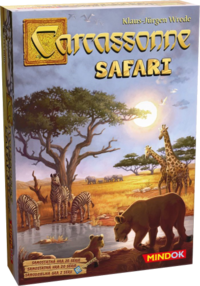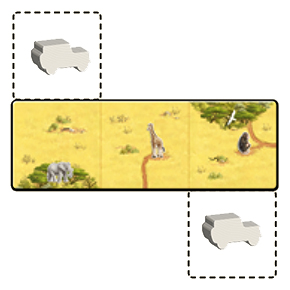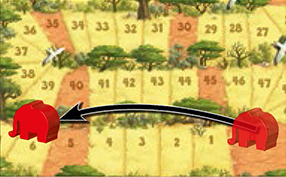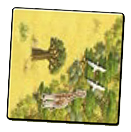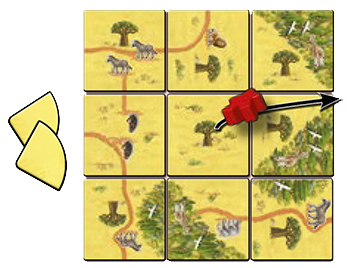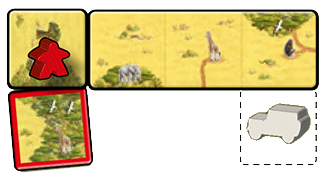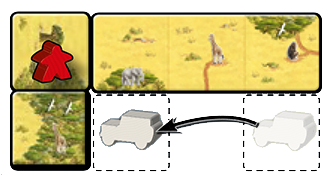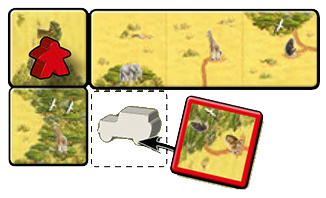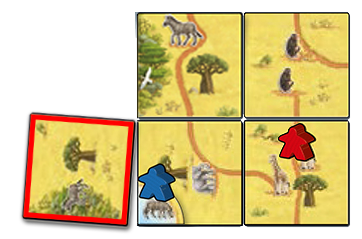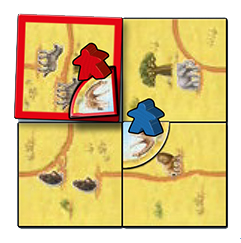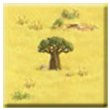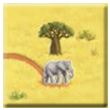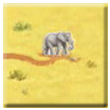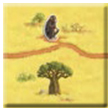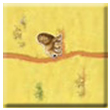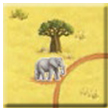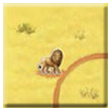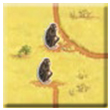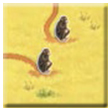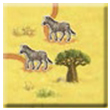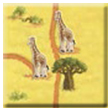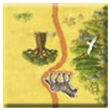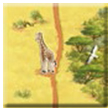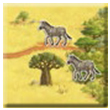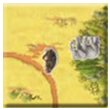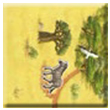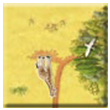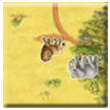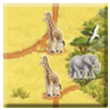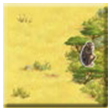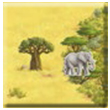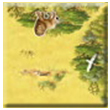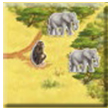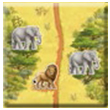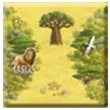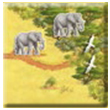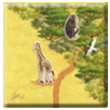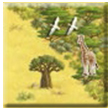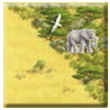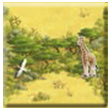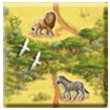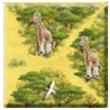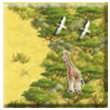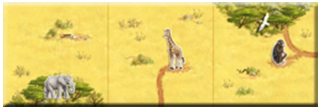Safari - Gra podstawowa
Strona główna > Safari > Safari Base Game/pl
Tropikalne upały nad Afryką... Wjeżdżamy na step, gdzie wszyscy szukają znanych, wspaniałych zwierząt. Małpy kołyszą się na gałęziach, lwy odpoczywają w cieniu drzew, ciężkie kroki słoni wstrząsają terenem. Przy wodopojach hasa wiele zwierząt, więc warto przyczaić się tam w oczekiwaniu.
Wstęp
Wydane przez Hans im Glück w 2018. W Polsce wydane przez Bard w 2018.
A note on the title: Today, the term “safari” is used primarily to describe observing wild animals in their natural habitat, and it is used in this sense throughout.
Zawartość i przygotowanie do gry
Zawartość
- 72 Płytki terenu ukazujące sawannę, ścieżki wydeptane przez zwierzęta, busz, wśród którego wypoczywają oraz baobaby.
- 1 start tile with the size of three land tiles.
- 50 żetonów zwierząt używanych do zwiększenia wyników punktacji oraz budowania wodopoju.
- Scoreboard
- 5 scoring markers showing 50 and 100
- 30 meeples, six in each of the following colors: yellow, red, green, blue and black
- 5 elephants, one in each player's color
- 2 white ranger vehicles - these are two neutral figures referred to as "rangers" throughout the rules. They don't belong to any player.
Preparation
Shuffle all 72 land tiles, and place them facedown in stacks that are easily accessible to all players. [1]
Place the start tile in the middle of the table and place the rangers in the spaces indicated in the illustration below.
Place the scoreboard to the side of the playing area. Place the score markers next to it.
Shuffle all 50 animal tokens and distribute two to each player. Each player puts them face up in front of them. Shuffle the rest of them and put them aside, face down. [2]
Each player chooses a color and takes the six meeples and one elephant of that color to form their personal supply. Place each player‘s elephant on the 0 space. Return all unused meeples and elephants to the box.
Cel gry
Krok po kroku ty i twoi przeciwnicy tworzycie krajobraz z płytek terenu. W trakcie gry odkryjecie sawannę a wśród niej - busz, baobaby i ścieżki zwierząt, na których możecie umieszczać podwładnych. Jeżeli jakiś element jest ukończony, otrzymujecie punkty za znajdujące się na nim zwierzęta. Używajcie żetonów, aby podnosić swoje wyniki bądź budować wodopoje na sawannie. Wszystkie te działania przyniosą wam punkty - w trakcie bądź na koniec gry. Po ich ostatecznym podliczeniu wyłonicie zwycięzcę.
Gameplay
Carcassonne Safari is played in turns, in clockwise order. Starting with the youngest player, the active player follows these steps in the order listed below, after which the next player takes a turn, and so on. Below is a brief description of the actions you will take on your turn and the different features on the land tiles.
The animal trails
1. Placing a land tile with an animal trail
If you draw a tile with an animal trail, you must place it such that it continues the existing landscape (including any savanna, animal trails, or bush). [3]
2. Placing a meeple on an animal trail
3. Scoring an animal trail
An animal trail is completed when both ends are closed by bush or savanna, or when it loops back onto itself by connecting to the other end. When the trail is completed, it is scored. If one of your meeples is on a trail when it scores, you will score points from it.
You score points based on the number of different animals present on the animal trail. The number of points scored is shown below, as well as on the scoreboard.
The total number of animals on the trail does not matter, only how many different animals are present. After scoring, return your meeple from the trail to your supply.
Placing additional animals
Before you would score points from an animal trail, you may add one animal tile from your supply to that trail. The animal tile must be an animal that is not already present on that trail.
Players track their scores using the elephants placed on the scoreboard at the start of the game. When you score points, move your elephant forward that many spaces. If your elephant passes the 0 space on the scoreboard, take a scoring marker and place it with the "50" side up in front of you. If your elephant passes the 0 space again, flip the scoring marker over to the "100" side.
Discard all animal tiles that were placed on the trail faceup. If a player would draw a new animal tile but there are none left in the supply, shuffle the discarded tiles facedown to create the new supply.
The Bush
3. Scoring a feature
A bush is completed when it does not have any open sides or gaps. When a bush is completed, it is scored. If one of your meeples is in the bush when it scores, you will score points from it. The points scored from animals in a bush are the same as those scored from
an animal trail (see table below). Additionally, each bird (![]() ) above the bush is worth 1 point.
) above the bush is worth 1 point.
After scoring a bush, return your meeple from the bush to your supply.
Placing additional animals
Before you would score points from a bush, you may add one animal tile from your supply on that bush. The animal tile must be an animal that is not already present in that bush, and the animal tile is discarded after the bush is scored.
The Baobab Tree
3. Scoring a feature
When all eight spaces around a baobab tree have tiles placed on them, return your meeple from that tree to your supply, then draw two additional animal tiles from the supply and place them faceup in front of you. You do not score any points from the baobab tree.
Interim rule - note on interim rules
Since animal tokens for completing a baobab are received in the scoring phase, it is unclear at this moment if the player can use either of the two animal tokens in the same turn to boost the score of another, scoreable, feature, if it is completed by placing the tile. We recommend allowing immediate use. Alternatively, you can use an animal token received for placing a meeple on a baobab in a previous phase.
The Ranger
During your turn, the rangers can be used in one of two ways:
- Option A: The tile does not displace a ranger
3a. Score features
Score all features completed by the tile you placed. You do not score points for moving the ranger.
- Option B: The tile displaces a ranger
Note: You may only move one ranger per turn. If you displaced a ranger with your tile (1b), you may not move a
ranger instead of placing a meeple (2a). The two rangers can never occupy the same space.
The Watering Holes
In addition to using animal tiles to improve your score for animal trails and bush, you can also use them to dig watering holes in the savanna.
1. Placing a land tile
You draw a land tile and place it, continuing the landscape as normal.
2. Dig or expand a watering hole
Dig a watering hole
Instead of placing a meeple on a tile, you may start digging a watering hole. To do so, place an animal tile from your supply onto an open corner of any tile (not necessarily the tile you just placed). A corner is open if it depicts only savanna (no bush). Then place a meeple on that animal tile and immediately score 3 points.
![]() Pytanie: The rules say that you can start a Watering Hole at the empty savanna corner of a tile. However, once a Watering Hole has started, can a player place a tile with Bush segment next to the Watering Hole? See the picture below.
Pytanie: The rules say that you can start a Watering Hole at the empty savanna corner of a tile. However, once a Watering Hole has started, can a player place a tile with Bush segment next to the Watering Hole? See the picture below.
If a player places a Bush segment there, the Watering Hole can never be completed, and the meeple is stuck for the rest of the game. Is this allowed?
Expanding a watering hole
Instead of placing a meeple on the tile you just placed, you may expand a watering hole. Place an animal tile onto a land tile such that it continues to close the circle of the watering hole.
You must use an animal tile depicting a different animal than the animals already present at the watering hole. You do not place a meeple onto this animal tile.
Depending on whether you placed the second, third, or fourth (and last) animal tile on a watering hole, you score points as follows:
- Second animal tile: 4 points
- Third animal tile: 5 points
- Fourth animal tile: 6 points
Note: You may not start digging a watering hole without placing a meeple on it.
Exception: You may start digging a new watering hole diagonally across from an existing watering hole. Since the animal tiles do not touch yet, you place a meeple on this tile. Once the watering hole is complete, two meeples will occupy it. In this instance, it is possible for two of the same animal to occupy the watering hole.
Interim rule - note on interim rules
Although the animal tokens may, at some later point, be connected to form a single waterhole, this token begins a new watering hole, so the player receives 3 points.
3. Scoring a watering hole
When the fourth animal tile of a watering hole is placed, it is complete. The owner of the watering hole scores three points. If two meeples occupy the watering hole, both players score three points. If both meeples belong to the same player, that player still only scores 3 points.
Return all meeples from the watering hole to their owners.
Multiple meeples on the same feature
Although you may not place a meeple on a feature (an animal trail or bush) that is already occupied by a meeple, it is possible that, by connecting separate features, multiple meeples will occupy the same feature. When a feature with multiple meeples on it is scored, only the player with the most meeples on that feature scores points. If there is a tie for the most meeples on a feature, all tied players score the full amount of points. If multiple players have meeples on the same feature, all scoring players may add a different animal to the feature before scoring. Animal tiles only add to the score of the player who placed them.


Summary
1. Placing a Land tile
- You must place the tile you drew such that it continues the landscape and connects with existing features.
- If you are unable to place the tile you drew, return it to the box and draw a new one.
- If you place a tile in a space occupied by a ranger, you displace the ranger.
2. Placing a meeple
- You may place a meeple only on a feature on the land tile you just placed. When doing so, you must ensure that another meeple is not already occupying the feature you are placing on.
- If you lay a meeple on a baobab tree, you draw two animal tiles.
- If you do not place a meeple, you may instead dig a new watering hole, expand a watering hole, or move a ranger.
3. Scoring a feature
- Completed features are scored at the end of each turn. After scoring, players return their meeples from the scored features to their supply.
- A completed animal trail scores points based on the number of different animals present.
- A completed bush scores points in the same way as a completed animal trail, plus 1 point per bird.
- A completed baobab tree allows you to draw two additional animal tiles.
- A completed waterhole scores 3 points. [4]
- Placing a ranger after being displaced by the tile just placed scores 3 points. [4]
- If there are multiple meeples on a single scored feature, the player with the most meeples is the only one who scores. If multiple players are tied, the tied players all score full points.
Game end and final scoring
The game ends after a player draws the last land tile. That player takes their turn, then final scoring is conducted as follows:
- Animal trails and bush
- The player with the most meeples on the feature scores 1 point for every animal and bird present. Different types of animals do not matter. [5]
- Animal tiles
- You score 1 point for each animal tile in your supply.
- Baobab trees and watering holes
- Meeples on baobab trees and watering holes do not score points.

A: Blue does not score any points for the meeple on the baobab tree.
B: You score 2 points for the two animals on the trail.
C: You and Blue have meeples in the large bush. Since you has more meeples than Blue there, you get the points for the animals. With four animals and six birds in the bush, you score 10 points. [6]
D: Blue scores 2 points for the one animal (ape) and one bird in the small bush.
E: You score 3 points for animal tiles in your supply.
After final scoring is complete, the player with the most points wins. If multiple players are tied, they share the victory. [7]
Use of a Table
A number of questions have been asked about rules related to the play area itself [8], including what happens when the edge of the area is reached, or if a table has to be used for play. The following clarifications are from Georg Wild from HiG (5/2013):
- The edge of the table is the limit for the game if, as stated in the rules, a table is used.
- The rules state that the starting tile is placed in the middle of the table. If all of the tiles are shifted to allow more room, the starting tile would no longer be in the middle. So in principle, total shifting of the tiles is not allowed. Additionally, with a manual shift of all of the tiles, the tiles and figures on the play area can slip, which could lead to incorrect positioning of tiles or figures.
- Addition of a second table is possible if one of an appropriate height is added to the first table. If a table is extended (as with an additional panel), make sure that the tiles and figures on the play area do not slip.
- Playing on the floor: The rules technically do not allow this, because the rules state that the first tile is placed in the middle of the table. Playing on the floor is not forbidden, however, if use of a table is not feasible. If the floor is used, tiles must be placed so all tiles are visible to all players. Tiles cannot be placed under the sofa, cabinet/shelf, etc.
- It is important generally, that all the players in the round agree how to play:
- Table - standard
- Table - with "total shifting" of tiles
- Table - with extension
- Floor
- Continue to play fairly and not intentionally unfair to other players.
Tile reference
Total Land Tiles: 72 Tiles + 1 Start Tile
If several tiles of one type are present, it is listed which and how many animals are on each one.
The individual tiles are separated by a pipe symbol. Birds are not listed.
A = ape | E = elephant | G = giraffe | L = lion | Z = zebra | "-" = no animal
Total animal / watering hole tiles: 50
Letters indicate the animal included on each land tile:
A = ape | E = elephant | G = giraffe | L = lion | Z = zebra
Total 50/100 scoring markers: 5
Przypisy
W celu zapoznania się z objeśnieniami ikon oraz licencjami odwiedź: Ikony.
- ↑
 Tiles can also be placed into a bag or box to be drawn randomly.
Tiles can also be placed into a bag or box to be drawn randomly.
- ↑
 It is much more convenient to put the animal tokens into a small bag and draw them randomly as required.
It is much more convenient to put the animal tokens into a small bag and draw them randomly as required.
- ↑
 In the rare case that a tile cannot legally be placed anywhere, it is removed from the game, and the player draws another.
In the rare case that a tile cannot legally be placed anywhere, it is removed from the game, and the player draws another.
- ↑ Jump up to: 4.0 4.1
 Although not included in the manual, included here for the sake of completeness.
Although not included in the manual, included here for the sake of completeness.
- ↑
 The ZMG rules allow all players present in the feature to score (not only those with the majority as stated by HiG):
The ZMG rules allow all players present in the feature to score (not only those with the majority as stated by HiG):
- Each player with a meeple on the feature scores 1 point for every animal and bird present. Different types of animals do not matter. All players with meeples on the feature score points, regardless of who has the most meeples.
- ↑
 The translation of the same example in the ZMG rules reads as follows (aligned with the discrepancy in the previous footnote):
The translation of the same example in the ZMG rules reads as follows (aligned with the discrepancy in the previous footnote):
- You and Blue have meeples in the large bush. With four animals and six birds in the bush, you and Blue both score 10 points.
- ↑
 Once the final score is known, the winner is the player with the most points. The rules do not include tiebreakers. That is, rules explaining the situation when two or more players share the same score at the end of the game.
Once the final score is known, the winner is the player with the most points. The rules do not include tiebreakers. That is, rules explaining the situation when two or more players share the same score at the end of the game.
- ↑
 These clarifications where provided for the Carcassonne game and can also be applied to any spin-offs, including Safari.
These clarifications where provided for the Carcassonne game and can also be applied to any spin-offs, including Safari.
